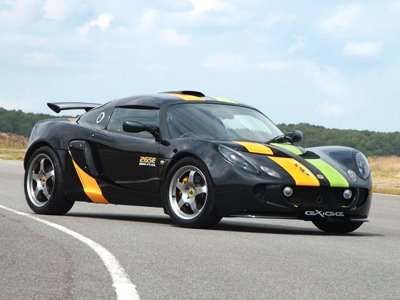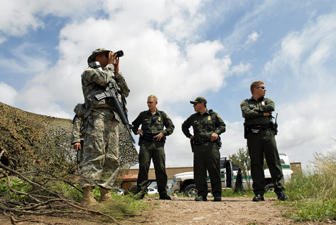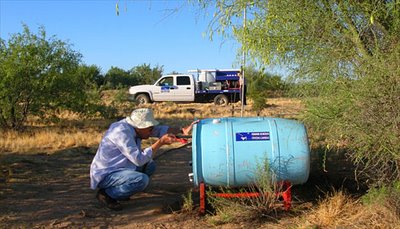 The Lotus Exige 265E - the most powerful road version of the Lotus Exige ever - and it runs on environmentally friendly Bio Fuel! The 265 stands for the horsepower, while the E stands for the environmentally favourable E85 fuel. Image Credit: HSPN Global News
The Lotus Exige 265E - the most powerful road version of the Lotus Exige ever - and it runs on environmentally friendly Bio Fuel! The 265 stands for the horsepower, while the E stands for the environmentally favourable E85 fuel. Image Credit: HSPN Global NewsNot one week since General Motors sets three land speed records using E85 out at Bonneville salt flats, British automobile manufacturer, Lotus, announces the first exotic street roadster that will run on the cooler running, more powerful E85.
For General Motors part, this from Paddock Talk -
GM and Partners Set Three New Land Speed Records at Bonneville Salt Flats
Posted by: ASkyler on Aug 22, 2006 - 04:47 PM
GM Performance Division and its partners from So-Cal Speed Shop set three new land speed records with Ecotec-powered vehicles last week during the 58th Annual Speed Week event at the Bonneville Salt Flats in Wendover, Utah, including the first-ever Bonneville record using E85 ethanol. Ecotec-powered vehicles have now set eight records during the past four years with some form of GM involvement.
“The Ecotec is one of the most adaptable and durable four-cylinder engines in the marketplace, and it continues to prove its mettle on the hallowed Salt Flats,” said GM Performance Division executive Al Oppenheiser, whose team heads up GM’s efforts at Bonneville. “We even had one impartial member of the media call the engine ‘bulletproof’ last week, which is a testament to our powertrain organization.”
The team never looked back after setting two records on Aug. 13 in the G/FCC class (G Class/Unblown Fuel Competition Coupe) with the Bonneville Student Project Chevy Cobalt SS and the G/BFALT class (G Class/Blown Fuel Altered Coupe) with the Chevy So-Cal Cobalt SS during the first record return runs of the week.
Both cars were driven by GM Performance Division engineer Mark Dickens, and each vehicle upped its initial record in subsequent race runs throughout the week.
Running only on E85 ethanol, the Student Project Cobalt SS broke the previous 19-year-old record of 152.626 mph set by Doc Jeffries in 1987 with a speed of 156.073 mph, and then upped that record twice using E85 combined with nitrous oxide to its final mark of 172.680 mph in the G/FCC class (G Class/Unblown Fuel Competition Coupe).
The car either qualified or set a record in every E85 race run of the week, and was converted to run on the renewable fuel by three female engineering student interns – 19-year-old Heather Chemistruck from Virginia Tech University, 21-year-old Lauren Zimmer from Purdue University and 21-year-old Sandra Saldivar of New Mexico State University .
“The fuel classes at Bonneville are wide open, and that allows a person to run anything from nitro-methane to methanol to gasoline and whatever else is out there,” said Dickens. “We put E85 up against some of the absolute most extreme fuels available, and to be able to initially break the record using only E85 is quite an accomplishment.”
Read All>>
 The Lotus Exige 265E is probably the world’s quickest road-legal E85 bio-ethanol car. Not only is the engine important to the performance but also so is the aerodynamic package, which creates 41.2 kg (90.64 lbs) of downforce - 19.3 kg (42.46 lbs) at the front and 21.9 kg (48.18 lbs) at the rear - at 160 km/h (100 mph). This downforce ratio between front (47%) and rear (53%) is balanced and remains constant at the speeds of which the Exige 265E is capable. Image Credit: HSPN Global News
The Lotus Exige 265E is probably the world’s quickest road-legal E85 bio-ethanol car. Not only is the engine important to the performance but also so is the aerodynamic package, which creates 41.2 kg (90.64 lbs) of downforce - 19.3 kg (42.46 lbs) at the front and 21.9 kg (48.18 lbs) at the rear - at 160 km/h (100 mph). This downforce ratio between front (47%) and rear (53%) is balanced and remains constant at the speeds of which the Exige 265E is capable. Image Credit: HSPN Global NewsSo, Lotus decided to announce its biofuel developments with one of the more nimble of its badged models, the Lotus Exige.
This from HSPN Networks -
Brittish, Racing and Very Green
By HSPN Global News covering Lotus - Published on 08/23/2006
The Lotus Exige 265E – the most powerful road version of the Lotus Exige ever – and it runs on environmentally friendly Bio Fuel! Lotus Engineering, the engineering consultancy division of Group Lotus Plc has developed a bio-ethanol E85 version of the Lotus Exige.
The research vehicle is a true Lotus (it weighs just 930 kg unladen) and is called the Lotus Exige 265E. 265 indicates the approximate horsepower and is consistent with the naming strategy of other one-off and limited run Lotus variants such as the Lotus Sport Exige 240R; the E indicates the environmentally favourable bio-ethanol E85 fuel (85% ethanol alcohol and 15% petrol / gasoline) that powers this extremely high performing sportscar.
Key to this performance is a slightly modified version of the 2ZZ VVTL-i supercharged and intercooled high revving 4-cylinder engine from the standard Lotus Exige S. This now gives an estimated set of performance figures that would thrash the majority of “Super-Unleaded” performance cars: 0-60 mph in 3.88 seconds, 0-100 mph in 9.2 seconds and a top speed of 158 mph! In fact, the Lotus Exige 265E is probably the world’s quickest road-legal E85 bio-ethanol car.
Key changes have been made to the fuel system, the engine calibration and the four fuel injectors mounted on the inlet manifold have been enlarged. Two additional fuel injectors have been fitted at the supercharger inlet to increase the amount of fuel being injected in to the engine under higher engine loads and to further cool the charge air prior to combustion.
----
The beauty of ethanol is its ability to produce more power in the engine than with conventional petrol / gasoline fuel. The Lotus Exige 265E now produces 264 hp (197 kW, 268 PS) at 8000 rpm, and 184 lbft (249 Nm) of torque (at 5500 rpm), up by 46 hp (34 kW, 47 PS) or 21% and 25 lbft (34 Nm) or 16% over the standard petrol / gasoline Exige S. With the total weight of approximately 930 kg (unladen), the power to weight is approximately 283 hp / tonne (211 kW / tonne, 287 PS / tonne).
Ethanol has less stored energy per unit volume than gasoline so the fuel economy is less, however as E85 ethanol is 85% sourced from renewable bio matter, there is a net reduction in carbon dioxide (CO2).
Geraint Castleton-White, Head of Powertrain for Lotus Engineering explains the rationale behind the Lotus Exige 265E technical demonstrator: “We wanted to prove the point that green sportscars can also be very high performing sportscars. The fact that we have produced a research version of the Exige that is more powerful than the standard road car is a testament to the benefits of going green. We are also pleased that this vehicle demonstrates our engineering capabilities, our understanding of flex fuel vehicles and our knowledge of emerging fuel technologies. It also promotes bio-ethanol as a fuel of choice for the enthusiastic driver as well as the environmentally conscious driver.
Mike Kimberley, Chief Executive of Group Lotus explains the Lotus ‘Green Strategy’:
”Lotus Engineering is actively pursuing technologies that will improve the efficiency and environmentally friendliness of engines in the future. Carbon dioxide reduction is a priority, as is anything that can reduce our reliance on fossil fuels. We are one of the world leaders in powertrain engineering especially in the internal combustion sector and we are researching into all areas of alternative and conventional fuels to get greater efficiencies, power, performance and reduce net emissions and Bio Ethanol research is one area where we are expert. The problems that are facing the automotive industry at the moment are challenging, and these solutions fit with the Lotus culture and expertise.”
Mike Kimberley continues: “We have decided to develop a thorough understanding of the techniques and technologies of what alternative fuels can achieve, to produce vehicles that are both fun to drive and environmentally friendly. We are also working, globally, on hybrid and electric vehicles together with governments and universities and as an engineering organisation we have a duty and a desire to promote these ideas to a worldwide customer base.”
----
The Lotus Exige 265E is purely a research vehicle for Lotus Engineering and Lotus does not intend to put the car into production or sell aftermarket kits for Lotus Cars.
The Lotus Exige 265E in more detail:
The Lotus philosophy is all about performance through light weight. The Exige 265E is built to the lightest specification possible without resorting to expensive and rare materials normally found in the rarefied environment of Formula One or Aerospace Industries where weight reduction is often considered more important than cost. The performance improvements of using bio ethanol have been made through increasing the power of the engine without increasing the weight of the engine and therefore the overall weight of the car.
The Engine
The heart of the Exige 265E is a Roots-type supercharger (with a sealed-for-life internal mechanism meaning that it does not require the use of the engine’s oil) and air to air intercooler attached to the tried and tested 4-cylinder, 1.8 litre 2ZZ-GE VVTL-i engine. Using a development of the supercharger and intercooler package from the Exige S, the Exige 265E has peak power of 264 hp (197 kW, 268 PS) at 8000 rpm, 184 lbft (249 Nm) of torque (at 5500 rpm) up by 46 hp (34 kW, 47 PS) or 21% and 25 lbft (34 Nm) or 16% over the standard gasoline Exige S. Maximum engine speed is 8000 rpm (8500 rpm transient for up to 2 seconds).
Ethanol produces more power in the engine than with conventional petrol / gasoline fuel. This is due, in part, to the additional oxygen atom attached to the ethanol alcohol molecule so helping the combustion process in the cylinder to burn more effectively, efficiently and with more power.
The roof scoop ensures that the air-to-air intercooler works as efficiently and effectively as possible in all climates and environments. All charge air ducting has been kept as short as possible with large diameter pipes making sure that the bends in these ducts are not too tight, to the benefit of throttle response and efficiency. The Roots-type Eaton M62 supercharger is run from the crankshaft, and has an integral bypass valve for part load operation.
Read All>>
















